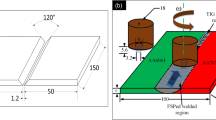Abstract
Impeller blades are often individual and complex-shaped components made of challenging metals. As the manufacturing of such blades is highly sophisticated, only a few companies worldwide possess the necessary processing knowledge and that is why long production times have to be accepted by customers. To overcome this economic disadvantage, manufacturing technologies are permanent under supervision and it seems that metal additive manufacturing could thereby play an important role in future. In this paper, wire arc additive manufacturing (WAAM) based on gas metal arc welding (GMAW) is considered. Shape-giving GMAW is well known in industrial manufacturing, but its application is limited due to restrictions by the welding process itself: For thinner wall thicknesses, a significant reduction of the weld process energy is required which increases the risk of process instabilities and spatter formation. Extensive welding process-related efforts have been undertaken to overcome this fact and a new GMAW process, called CMT (Cold Metal Transfer) was introduced. CMT is based on a high-frequency forward and backward movement of the welding wire electrode and provides an almost spatter-free and absolute precise, periodic detachment of accurately defined droplets from the filler wire at very low process energies. In combination with an accurate robotic movement of the CMT welding torch, geometries with minimum thicknesses in the range of 2–4 mm can be build up layer by layer. Additionally, a broad range of different, well established and third party-approved GMAW filler metals for joining is available. In this work, an impeller blade-like geometry out of duplex stainless steel has been manufactured by CMT using a filler wire type G 22 9 3 N L. The investigations have shown that the achieved surface roughness is comparable to sand casting and the microstructure is without any evidence for porosity and lack of fusion. Furthermore, an austenite/δ-ferrite weld microstructure with partly preferred grain orientations and a δ-ferrite content of around 30FN exists. The measured mechanical properties, especially strength and toughness, are comparable to data provided by the filler metal data sheet.













Similar content being viewed by others
References
Oesterreicher A, Wiener J, Roth M, Moser A, Gmeiner R, Edler M, Pinter G, Griesser T (2016) Tough and degradable photopolymers derived from alkyne monomers for 3D printing of biomedical materials. Polym Chem 7(Issue 32)
Korzhik VN, Khaskin VY, Grinyuk AA, Tkachuk VI, Peleshenko SI, Korotenko VV, Babich AA (2016) 3D-printing of metallic volumetric parts of complex shape based on welding plasma-arc technologies. The Paton Welding Journal No. 5-6
D Appelyard; Welding Pelton Runners, HRW-Hydro Review Worldwide (2012)
Schweißpraxis aktuell: CMT-Technologie; Fronius Int. GmbH, WEKA Media GmbH (2013); ISBN 978–3–8111-6879-4
Current Welding Practice CMT Technology; Fronius Int.; DVS Media GmbH (2014); ISBN 978–3–945023-36-5
J. Bruckner, K. Himmelbauer; Cold Metal Transfer—Ein neuer Prozess in der Fügetechnik; DVS-Berichte Band 237; 2005
Zhang H, Feng J, He P, Zhang B, Chen J, Wang L (2009) The arc characteristics and metal transfer behaviour of cold metal transfer and its use in joining aluminium to zinc-coated steel. Mater Sci Eng A 499(Issues 1–2)
Pickin C, Williams S, Lunt M (2011) Characterisation of the cold metal transfer (CMT) process and its application for low dilution cladding. J Mater Process Technol 211(Issue 3)
Williams S, Martina F, Adison A, Ding J, Pardal G, Colegrove P (2016) Wire + arc additive manufacturing. Mater Sci Technol 32(Issue 7)
Übersicht der Prozessregelvarianten des MSG-Schweißens; Merkblatt DVS 0973, DVS Media GmbH, Düsseldorf, 2014
Data sheet “Thermanit 22/09”; www.boehler-welding.com, 2014
ISO 15792-1 (2011) Welding consumables—test methods—Part 1: test methods for all-weld metal test specimens in steel, nickel and nickel alloys
EN ISO 15792-1 (2012) Schweißzusätze - Prüfverfahren - Teil 1: Prüfverfahren für Prüfstücke zur Entnahme von Schweißgutproben an Stahl, Nickel und Nickellegierungen
van Nassau L, Meelker H, Hilkes J (1993) Welding duplex and super-duplex stainless steels. Welding in the World 31(5)
Petzow G (1994) Metallographisches Ätzen; Gebr. Bornträger, Berlin
N. Erdmann, R. Campell, S. Asahina; Precise SEM cross section polishing via argon beam milling; Microscopy Today, 2006
EN ISO 14343 –A (2009) Welding consumables―wire electrodes, strip electrodes, wires and rods for arc welding of stainless and heat resisting steels―classification”
Valiente Bermejo MA, Karlsson L, Svensson L-E, Hurtig K, Rasmuson H, Frodigh M, Bengtsson P (2015) Effect of shielding gas on welding performance and properties of duplex and superduplex stainless steel welds. Welding in the World 59(2)
Valiente Bermejo MA, Karlsson L, Svensson L-E, Hurtig K, Rasmuson H, Frodigh M, Bengtsson P (2015) Effect of welding position on properties of duplex and superduplex stainless steel circumferential welds. Welding in the World 59(5)
Author information
Authors and Affiliations
Corresponding author
Additional information
Recommended for publication by Commission I - Additive Manufacturing, Surfacing, and Thermal Cutting
Rights and permissions
About this article
Cite this article
Posch, G., Chladil, K. & Chladil, H. Material properties of CMT—metal additive manufactured duplex stainless steel blade-like geometries. Weld World 61, 873–882 (2017). https://doi.org/10.1007/s40194-017-0474-5
Received:
Accepted:
Published:
Issue Date:
DOI: https://doi.org/10.1007/s40194-017-0474-5




